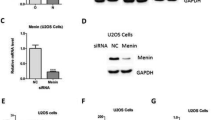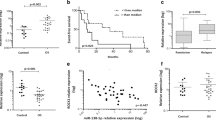Abstract
Osteosarcoma is the most common primary bone malignancy; however, the molecular mechanisms of development are not well understood. Progestin and AdipoQ receptors (PAQR3), a protein specifically localized in the Golgi apparatus, was recently characterized as a new tumor suppressor. Little is known about the expression and function of PAQR3 in osteosarcoma. Here, we showed that PAQR3 was downregulated in osteosarcoma tissues compared with the adjacent normal regions in 80 paired samples. Moreover, lower levels of PAQR3 were associated with metastasis in clinical osteosarcoma patients. In addition, overexpression of PAQR3 in the osteosarcoma cell line MG-63 inhibited cell proliferation, migration, and invasion by promoting ERK phosphorylation. Taken together, our results indicated that PAQR3 might act as a tumor suppressor in osteosarcoma, providing a novel diagnostic and therapeutic option for human osteosarcoma in the future.




Similar content being viewed by others
References
Rainusso N, Wang LL, Yustein JT. The adolescent and young adult with cancer: State of the art bone tumors. Curr Oncol Rep. 2013;15:296–307.
Namlos HM, Meza-Zepeda LA, Baroy T, Ostensen IH, Kresse SH, Kuijjer ML, et al. Modulation of the osteosarcoma expression phenotype by micrornas. PLoS One. 2012;7:e48086.
Zhao H, Guo M, Zhao G, Ma Q, Ma B, Qiu X, et al. Mir-183 inhibits the metastasis of osteosarcoma via downregulation of the expression of ezrin in f5m2 cells. Int J Mol Med. 2012;30:1013–20.
Yang J, Zhang W. New molecular insights into osteosarcoma targeted therapy. Curr Opin Oncol. 2013;25:398–406.
Cai H, Lin L, Tang M, Wang Z. Prognostic evaluation of microrna-210 expression in pediatric osteosarcoma. Med Oncol. 2013;30:499.
Chung JY, Kim JD, Park GH, Jung ST, Lee KB: Occipito-cervical reconstruction through direct lateral and posterior approach or the treatment of primary osteosarcoma in the atlas: a case report. Spine. 2011.
Liang W, Gao B, Fu P, Xu S, Qian Y, Fu Q. The mirnas in the pathogenesis of osteosarcoma. Front Biosci (Landmark Ed). 2013;18:788–94.
He C, Xiong J, Xu X, Lu W, Liu L, Xiao D, et al. Functional elucidation of mir-34 in osteosarcoma cells and primary tumor samples. Biochem Biophys Res Commun. 2009;388:35–40.
Cai CK, Zhao GY, Tian LY, Liu L, Yan K, Ma YL, et al. Mir-15a and mir-16-1 downregulate ccnd1 and induce apoptosis and cell cycle arrest in osteosarcoma. Oncol Rep. 2012;28:1764–70.
Zhu J, Feng Y, Ke Z, Yang Z, Zhou J, Huang X, et al. Down-regulation of mir-183 promotes migration and invasion of osteosarcoma by targeting ezrin. Am J Pathol. 2012;180:2440–51.
Kelly AD, Haibe-Kains B, Janeway KA, Hill KE, Howe E, Goldsmith J, et al. Microrna paraffin-based studies in osteosarcoma reveal reproducible independent prognostic profiles at 14q32. Genome Med. 2013;5:2.
Osaki M, Takeshita F, Sugimoto Y, Kosaka N, Yamamoto Y, Yoshioka Y, et al. Microrna-143 regulates human osteosarcoma metastasis by regulating matrix metalloprotease-13 expression. Mol Ther : J Am Soc Gene Ther. 2011;19:1123–30.
Zhou X, Wei M, Wang W. Microrna-340 suppresses osteosarcoma tumor growth and metastasis by directly targeting rock1. Biochem Biophys Res Commun. 2013;437:653–8.
Yan K, Gao J, Yang T, Ma Q, Qiu X, Fan Q, et al. Microrna-34a inhibits the proliferation and metastasis of osteosarcoma cells both in vitro and in vivo. PLoS One. 2012;7:e33778.
Fan L, Wu Q, Xing X, Wei Y, Shao Z. Microrna-145 targets vascular endothelial growth factor and inhibits invasion and metastasis of osteosarcoma cells. Acta Biochim Biophys Sin. 2012;44:407–14.
Wang L, Wang X, Li Z, Xia T, Zhu L, Liu B, et al. Paqr3 has modulatory roles in obesity, energy metabolism, and leptin signaling. Endocrinology. 2013;154:4525–35.
Wang X, Wang L, Zhu L, Pan Y, Xiao F, Liu W, et al. Paqr3 modulates insulin signaling by shunting phosphoinositide 3-kinase p110alpha to the golgi apparatus. Diabetes. 2013;62:444–56.
Zhang Y, Jiang X, Qin X, Ye D, Yi Z, Liu M, et al. Rktg inhibits angiogenesis by suppressing mapk-mediated autocrine vegf signaling and is downregulated in clear-cell renal cell carcinoma. Oncogene. 2010;29:5404–15.
Wang X, Li X, Fan F, Jiao S, Wang L, Zhu L, et al. Paqr3 plays a suppressive role in the tumorigenesis of colorectal cancers. Carcinogenesis. 2012;33:2228–35.
Ling ZQ, Guo W, Lu XX, Zhu X, Hong LL, Wang Z, et al. A golgi-specific protein paqr3 is closely associated with the progression, metastasis and prognosis of human gastric cancers. Ann Oncol: Off J Eur Soc Med Oncol / ESMO. 2014;25:1363–72.
Wu HG, Zhang WJ, Ding Q, Peng G, Zou ZW, Liu T, et al. Identification of paqr3 as a new candidate tumor suppressor in hepatocellular carcinoma. Oncol Rep. 2014;32:2687–95.
Saldana-Meyer R, Recillas-Targa F. Transcriptional and epigenetic regulation of the p53 tumor suppressor gene. Epigenetics : Off J DNA Methylation Soc. 2011;6:1068–77.
Lee SH, Ju SK, Lee TY, Huh SH, Han KH. Tip30 directly binds p53 tumor suppressor protein in vitro. Mol Cells. 2012;34:495–500.
Volodko N, Gordon M, Salla M, Ghazaleh HA, Baksh S: Rassf tumor suppressor gene family: Biological functions and regulation. FEBS Lett. 2014.
Tsuruta T, Kozaki K, Uesugi A, Furuta M, Hirasawa A, Imoto I, et al. Mir-152 is a tumor suppressor microrna that is silenced by DNA hypermethylation in endometrial cancer. Cancer Res. 2011;71:6450–62.
Zhang Y, Cai X, Schlegelberger B, Zheng S. Assignment1 of human putative tumor suppressor genes st13 (alias snc6) and st14 (alias snc19) to human chromosome bands 22q13 and 11q24– > q25 by in situ hybridization. Cytogenet Cell Genet. 1998;83:56–7.
Acknowledgments
This research project was supported by the National Natural Science Foundation of China grant No. 81272015 and Heilongjiang Postdoctoral Fund No. LBH-Z12189.
Conflicts of interest
None
Author information
Authors and Affiliations
Corresponding author
Electronic supplementary material
Below is the link to the electronic supplementary material.
ESM 1
(DOC 43 kb)
Rights and permissions
About this article
Cite this article
Ma, Z., Wang, Y., Piao, T. et al. The tumor suppressor role of PAQR3 in osteosarcoma. Tumor Biol. 36, 3319–3324 (2015). https://doi.org/10.1007/s13277-014-2964-z
Received:
Accepted:
Published:
Issue Date:
DOI: https://doi.org/10.1007/s13277-014-2964-z




